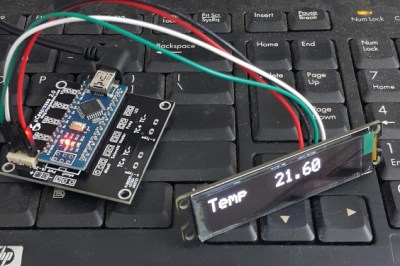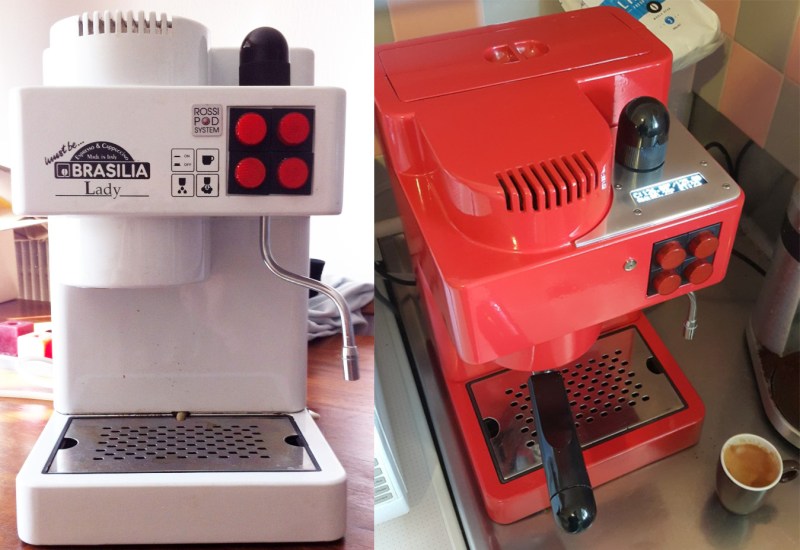Coffee, making and hacking addictions are just bound to get out of control. So did [Rhys Goodwin’s] coffee maker hack. What started as a little restoration project of a second-hand coffee machine resulted in a complete upgrade to state of the art coffee brewing technology.
 The Brasilia Lady comes with a 300 ml brass boiler, a pump and four buttons for power, coffee, hot water and steam. A 3-way AC solenoid valve, wired directly to the buttons, selects one of the three functions, while a temperamental bimetal switch keeps the boiler roughly between almost there and way too hot.
The Brasilia Lady comes with a 300 ml brass boiler, a pump and four buttons for power, coffee, hot water and steam. A 3-way AC solenoid valve, wired directly to the buttons, selects one of the three functions, while a temperamental bimetal switch keeps the boiler roughly between almost there and way too hot.
To reduce the temperature swing, [Rhys] decided to add a PID control loop, and on the way, an OLED display, too. He designed a little shield for the Arduino Nano, that interfaces with the present hardware through solid state relays. Two thermocouples measure the temperature of the boiler and group head while a thermal cut-off fuse protects the machine from overheating in case of a malfunction.
Also, the Lady’s makeup received a complete overhaul, starting with a fresh powder coating. A sealed enclosure along with a polished top panel for the OLED display were machined from aluminum. [Rhys] also added an external water tank that is connected to the machine through shiny, custom lathed tube fittings. Before the water enters the boiler, it passes through a custom preheater, to avoid cold water from entering the boiler directly. Not only does the result look fantastic, it also offers a lot more control over the temperature and the amount of water extracted, resulting in a perfect brew every time. Enjoy [Rhys’s] video where he explains his build:
Thanks to [Pirate14] for the tip!
















I think I’ve seen this before… oh yeah, it was right here
http://hackaday.com/2015/07/06/restoring-an-espresso-machine-to-the-21st-century/
Only 3 days off the original publishing date or it would have been an anniversary.
Heh, that’s what happens when you write about coffee while lacking thereof. Great hack anyway, worthy of warming it up again.
You have to turn the screen 90° to watch the video.
Great build blog though!
https://img1.etsystatic.com/066/0/9992333/il_570xN.751211835_dzne.jpg
Upgrading your Espresso machine with a PID is quite common around here. A very nice build, though.
One suggestion: If you can manage to measure the offset from the water being let out from the head onto the actual coffee towards the boiler temperature, you can add that offset to the measurement of the boiler for display. Advantage of this is that you can actually COMPARE the brewing temperature for different “beans” (quotation marks put there for a purpose: To avoid nitpicking that they aren’t beans) with other coffee-users. If everyone just uses his own boiler temperature as a reference, it gets quite tricky.
I have a few coffee “types” that need a VERY tight temperature setting (around 96° Celsius). 2 degree more or less will make the coffee undrinkable.
There are a few tricks to get the actual brewing temperature measured (for the offset), one is to put a sensor into a blind filter with only a hole for the sensor’s wiring. Someone even built a brewing-temperature-measuring filter holder, but I think he doesn’t sell those any more …
I bet you have the best coffee in the town/city. :)
I’ll never go back to convenience store coffee or a certain chain that sells donuts (to dunk in, of course) again!
99% of the job is the mechanical aspect. Using a pre-made board (be it a dedicated PID controller or an arduino with a few lines of code) and a SSR is damn easy. What’s not so easy is placing the temperature sensor, making perfect rectangular holes for an LCD display and so on.
Also, that’s not a boiler, it’s a thermoblock. A boiler wouldn’t really need it either.
I’m using a machine with a nice brass boiler and a E61 group head (paired with a baratza vario) so no PID needed here!
Stupid question here… It’s an espresso machine, so it brews with steam, not hot water? Surely steam is always >=100C (unless you’ve got a significantly different pressure), so what do you mean when you say you brew at 96C?
What am I not getting? I use an aeropress, so my understanding of espresso machines is probably lacking.
Espresso machines use steam for the milk. The coffee is generally pumped at high pressure from a boiler.
The really cheap ones use boiling water to generate the pressure.
I use an aero press too. The cost to get a capable machine I find prohibitive.
Thanks!
Now all that is missing is a good quality grinder (anyone who knows anything about coffee knows that you can only get GOOD coffee from freshly ground coffee beans :)
Having chosen a name that requires proof, I’d say:
4M.
M1 = Material (coffee, we don’t know about what [Rhys] uses)
M2 = Machine (with PID we are getting somewhere, check)
M3 = Mill (grinder, unknown)
M4 = Man (well, [Rhys] has taken an important step there …)
Fail in one M and you fail in making good coffee
Nice. Sometimes I wish I appreciated good coffee rather than glugging ~15 cups of bean-to-cup a day like a coding tramp…
https://media.giphy.com/media/3o7WTrvW0BNBaHrF4c/giphy.gif
*pERfect cup of energy
:)
Nah dude prefect fits, its a play on words.
what would that play be?, i’ve missed it…
I am no english native..
I wonder that is the difference between boiler and group is you leave it on for like 30 mininutes. Did you try to flush before extraction?
Can someone configure a bluetooth WIFI controller to communicate with my Cloud app?